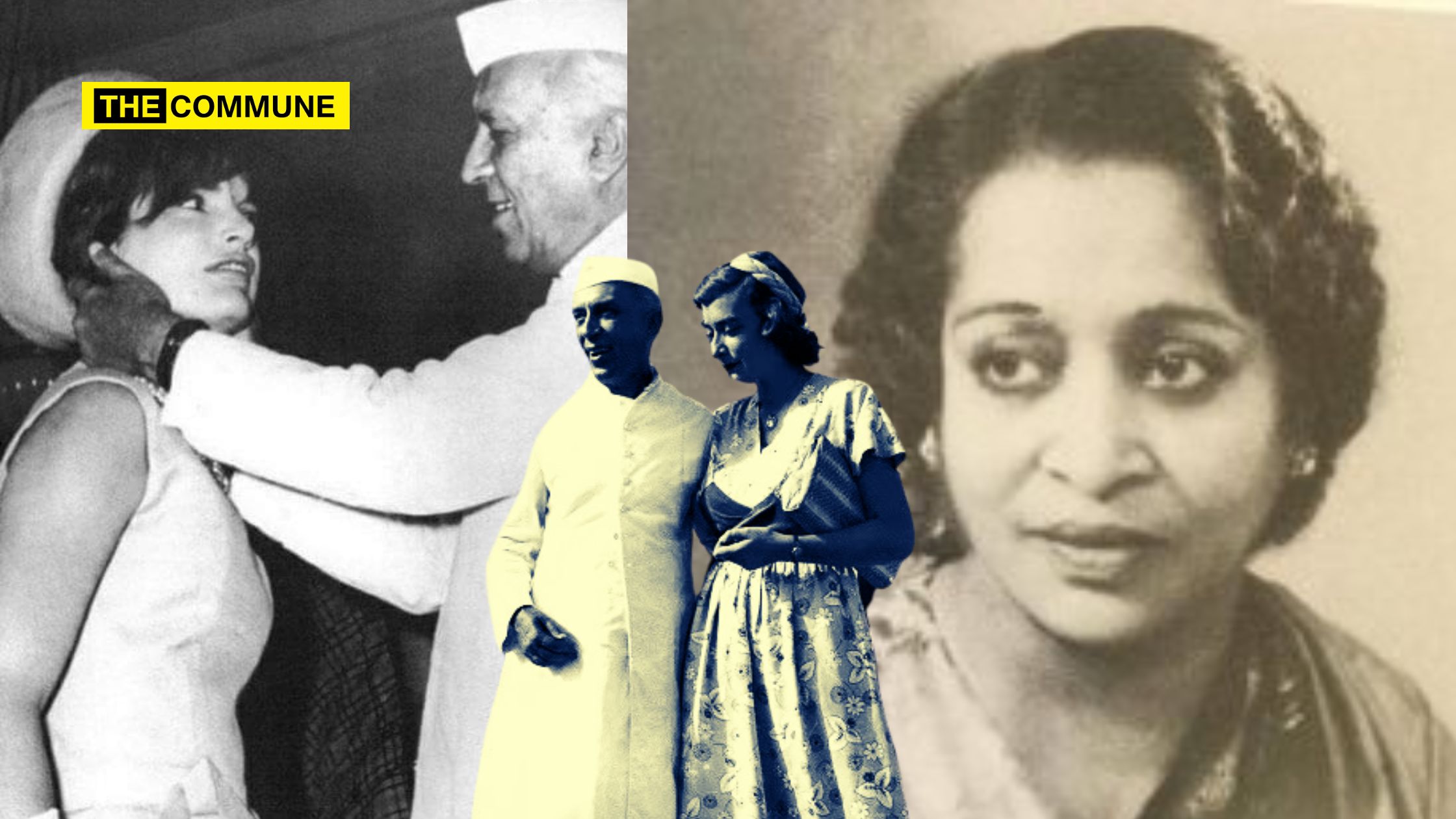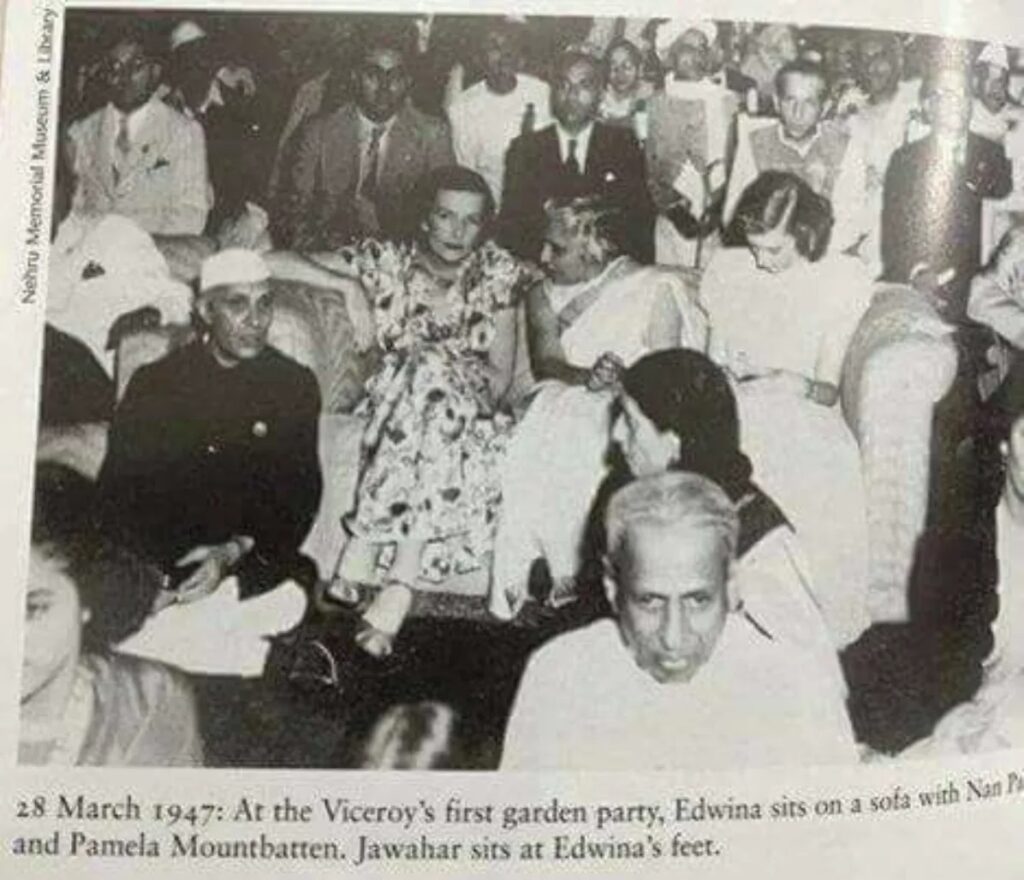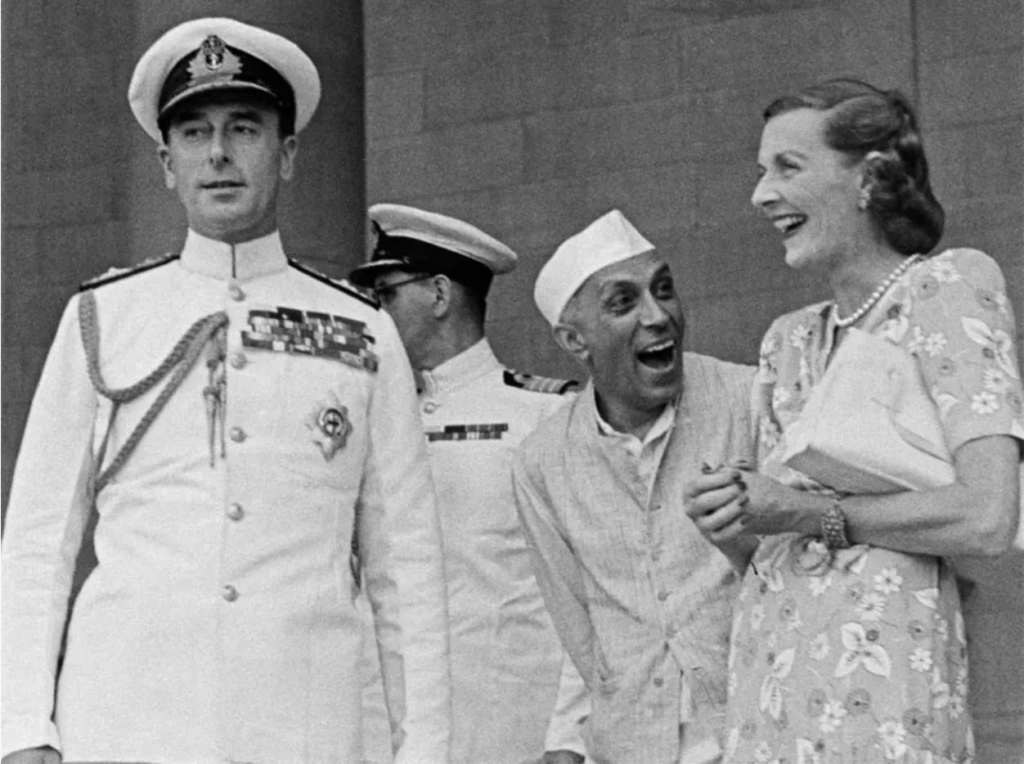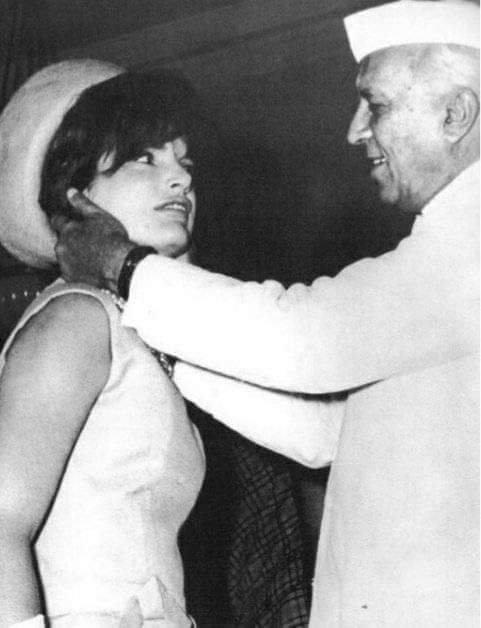
Jawaharlal Nehru, India’s first Prime Minister, is often portrayed by politicians as a visionary for a modern, secular India, but his personal life, particularly his relationships with prominent women of his time, has always left people wondering if this was the same Nehru that people praised so much. Historical accounts and letters suggest that Nehru’s flirtatious character, which is referred to as “charisma” to be politically correct, extended beyond his political sphere and earned him a reputation as a “ladies’ man.” His close relationships with women like Lady Edwina Mountbatten and his “admiration” for former American first lady, Jacqueline Kennedy have been the subject of considerable scrutiny.
It must be noted that Nehru and Kamala’s arranged marriage in 1916 began with challenges as the young Kamala struggled to fit into the politically active, English-speaking Nehru family. However, Kamala’s health declined in later years due to tuberculosis, and Nehru was deeply affected by her suffering. Her death in 1936 left an enduring void in his life, reflected in his writings. Did this “void” make him “seek” companionship with other women?
Let’s take a look at each one of these women in Nehru’s life.
Lady Edwina Mountbatten
The connection between Jawaharlal Nehru and Lady Edwina Mountbatten has been a topic of intense scrutiny for decades. Edwina, the wife of Lord Louis Mountbatten, the last Viceroy of British India, met Nehru during the final days of the British Empire’s rule in India. Their “friendship” blossomed rapidly, evolving into a deep, affectionate relationship that would span years. Historical records, including letters and memoirs, reveal intimate exchanges and a profound emotional bond between the two.
The Nehru-Edwina relationship was especially controversial because Edwina was married to a powerful British official, yet her affection for Nehru was open enough that Lord Mountbatten reportedly accepted their closeness. Louis Mountbatten’s own statements suggest that he saw Edwina and Nehru’s connection as one of mutual respect and emotional intimacy. For Nehru, Edwina was a “confidante with whom he could share personal thoughts“, particularly during the challenging early years of Indian independence.
Nehru was so close with Edwina that he sent the INS Trishul for her funeral!
Mountbatten’s daughter has acknowledged that her father used Edwina to influence Nehru in Kashmir. According to the book, Daughter of Empire: Life as a Mountbatten, first published in 2012 in the United Kingdom, Pamela claimed that Edwina and Nehru were in love but they didn’t have a physical relationship.
On February 21, 1960, Edwina Mountbatten was found dead, with a pile of letters from Jawaharlal Nehru by her side. The two shared a close relationship that began when Edwina and her husband, Louis Mountbatten, arrived in Delhi on 22 March 1947, amidst India’s turbulent path to independence. While the Mountbattens had a strained relationship with Jinnah, they quickly bonded with Nehru. A photograph from March 28, 1947, captured the closeness between Edwina and Nehru, who sat at her feet. Their relationship intertwined both affection and influence during a critical period in India’s history.


Edwina’s wish was to be buried at sea, a request honored in 1960 after her death at age 59. Family members, including Prince Philip’s mother, Princess Andrew of Greece, gathered as her coffin was taken aboard HMS Wakeful off Portsmouth. Lord Mountbatten and their daughters joined the Archbishop of Canterbury in a solemn ceremony, releasing her remains 12 miles out at sea. An additional tribute came from Nehru, who sent the Indian Navy frigate INS Trishul to accompany Wakeful “and, on Panditji’s instructions, marigolds were scattered upon the waves”.
The relationship between Jawaharlal Nehru and Edwina Mountbatten is featured in the popular Netflix series The Crown, a historical drama that explores Queen Elizabeth’s life, reign, and the private lives of the British royals. In the very first episode of Season 1, during Queen Elizabeth and Prince Philip’s wedding, Winston Churchill seems to suggest that Lord Mountbatten played a key role in “losing India” for Britain. Others at the ceremony echo this sentiment. Later, in Season 2, Lord Mountbatten acknowledges his wife Edwina’s relationship with Nehru in a conversation with Queen Elizabeth.
Edwina’s presence in Nehru’s life and her impact on him is seen as profound, though her daughter Indira Gandhi reportedly viewed Edwina with disfavour due to her closeness with Nehru.
Nehru’s “vulnerability” to Edwina’s influence, even subconsciously, has led some to question the objectivity of his political choices concerning Britain.
Padmaja Naidu
Padmaja Naidu’s relationship with Nehru represents yet another facet of his associations with women – one allegedly based on shared intellectual and political ideals. Jawaharlal Nehru’s relationship with Padmaja Naidu, the daughter of Sarojini Naidu, was marked by deep personal and emotional ties. Nehru and Padmaja shared a very close bond, often communicating through letters, some of which reflected a more intimate and complex dynamic between them. Some of the letters have been published in the book Selected Works of Jawaharlal Nehru, Volume 1.
The love story between Jawaharlal Nehru and Padmaja Naidu is a poignant and complex chapter in Indian history. After the death of his wife, Kamala Nehru, in 1936, Nehru became emotionally isolated. During this time, he grew closer to Padmaja, the daughter of Sarojini Naidu, a fellow freedom fighter. Their relationship blossomed in the late 1930s, with Nehru writing nearly 50 personal letters to Padmaja, some of which were love letters. Nehru affectionately called her “Bebee” in his letters, expressing admiration for her affection.
At one point, Nehru is even alleged to have considered marrying Padmaja, who was 11 years younger than him. However, the marriage never took place. Nehru’s daughter, Indira Gandhi is said to have played a crucial role in this decision. After Kamala Nehru’s death, Indira was emotionally vulnerable and required Nehru’s care, leading him to cancel the marriage plans. Indira was reportedly not fond of their relationship and even removed pictures of Padmaja from Nehru’s room, which led to a heated argument between father and daughter.
The situation grew more complicated with the arrival of Edwina Mountbatten, whom Nehru became close to. Padmaja, feeling jealous, withdrew from Nehru and even threatened suicide, later offering to hand over all the letters Nehru had written to her to Indira. After Nehru’s death, Padmaja continued to live near his residence, at Teen Murti Bhawan, where she cherished memories of him. She passed away on May 2, 1975.
A letter dated November 1946, which is found in Selected Works of Jawaharlal Nehru, Volume 1, illustrates Nehru’s candid reflections during a turbulent time in India’s history.
In this particular letter, Nehru describes his emotional reaction to the violence that erupted in Bihar following the Noakhali massacre, where Hindu peasants had risen against the Muslim atrocities in Bengal. In a letter to Sarojini Naidu’s sister and his alleged lover, Padmaja Naidu, Nehru said he was “relieved” over the murder of 400 Hindus.
“My dear,
Why exactly I am writing to you just at this present moment, nearing midnight, when I am tired out, I do not quite know. But suddenly after the excessive strain of the last two days, I had a feeling of reaction and relaxation and I thought of you and wanted to write.
This evening I returned by air from Bhagalpur. On arrival, I learnt that the military had fired on a peasant mob in the rural areas some miles from here, and about 400 had been killed. Normally such a thing would have horrified me. But would you believe it? I was greatly relieved to hear it! So we change with changing circumstances as layers of fresh experience and feeling cover up the past accumulation.”
“I have had horror enough during the past two days. Something incredible has happened here, or something that I would have refused to believe in, a few days ago. Hindu peasant mobs have behaved in a manner that is the extreme of brutality and inhumanity. How many have been done to death by them I do not yet know, but it must be a vast number. To think that the simple, unsophisticated, rather likable Bihar peasant can go completely mad en masse upsets all my sense of values.”
Without referencing the Hindu pogrom in Noakhali, he asserted that Hindus in Bihar had been unrestrained in their retaliation. In the letter, he emphasized that a careful equilibrium had been maintained by authorizing security forces to engage in large-scale killings of Hindus. He added, “For a few days they had it their own way, with few checks or hindrances. And so when the news came that they have been stopped at last in one place and that 400 of them had died, I felt that the balance had been very slightly righted.”
2/7
On Nov. 4th, Nehru threatened Hindus saying the “Govt. would not show any mercy…. they will be FIRED UPON & BOMBED from the air if necessary”. He exhorted Hindus whose families were raped & massacred at Noakhali to protect Muslims “even at the cost of sacrificing your all”! pic.twitter.com/zUiSXZMuyV— Savitri Mumukshu – सावित्री मुमुक्षु (@MumukshuSavitri) November 14, 2023
The letter reveals a rather unsettling perspective of Nehru during this period, where he seemed to justify the deaths of Hindus in Bihar while failing to address the magnitude of the earlier atrocities in Noakhali.
“Admiration” For Jacqueline Kennedy
Nehru’s admiration with Jacqueline Kennedy, the young and glamorous First Lady of the United States, added another layer to his complex image. Their interactions began when Jackie visited India in 1962, a visit that generated significant media interest. Nehru was in his early seventies at the time, while Jackie was young and considered one of the most beautiful and fashionable women globally. Their public appearances together were closely documented, and photos often showed Nehru visibly charmed by Jackie’s presence.

Critics argue that Nehru’s enthusiasm for Jackie’s visit was a distraction at a time when India faced severe domestic issues, including economic challenges.
In a 2016 public event video, Bruce Riedel, a former CIA analyst and author of JFK’s Forgotten Crisis, discussed an interesting incident involving Jawaharlal Nehru and Jacqueline Kennedy. Riedel revealed that Nehru was “smitten” by the U.S. First Lady, mentioning that the Indian Prime Minister kept a photograph of her on his bedside table for the rest of his life. He quickly added that while the gesture was unusual, it highlighted the significant diplomatic role Jacqueline Kennedy played in fostering U.S.-India relations.
But here is what Jackie thought of Nehru. Jacqueline Kennedy, the First Lady of the United States, did not have a positive relationship with Jawaharlal Nehru or his daughter, Indira Gandhi, as revealed in the book ‘Jacqueline Kennedy: Historic Conversations on Life with John F Kennedy‘. When Nehru visited the U.S. in November 1961, John F. Kennedy referred to the visit as “the worst head-of-state visit” and made a derogatory comment about Nehru’s final days in power, describing it as “the town preacher being caught in the whorehouse.” Jackie Kennedy shared her distaste for Indira Gandhi, calling her a “real prune” and criticizing her as “bitter, kind of pushy, [and] horrible.” She also remarked that Indira always looked like “she’s been sucking a lemon.” These sentiments reflect the personal tension between the Kennedys and the prominent Indian leaders during their interactions.
Nehru’s relationships with powerful women—intellectual companions or political confidantes—reveal a man whose personal life was as complex and controversial as his leadership. While some revere him as a visionary architect of modern India, others see his flirtations and emotional dependencies as a distraction from the grave responsibilities of his office. His alleged infatuations with women like Edwina Mountbatten, Padmaja Naidu, and Jacqueline Kennedy raise serious questions about his focus and priorities during India’s tumultuous early years of independence. Was the man who shaped a nation too entangled in his personal whims to steer the course of history truly? The truth may be less flattering than the iconic legacy he carefully crafted.
Subscribe to our channels on Telegram, WhatsApp, and Instagram and get the best stories of the day delivered to you personally.




